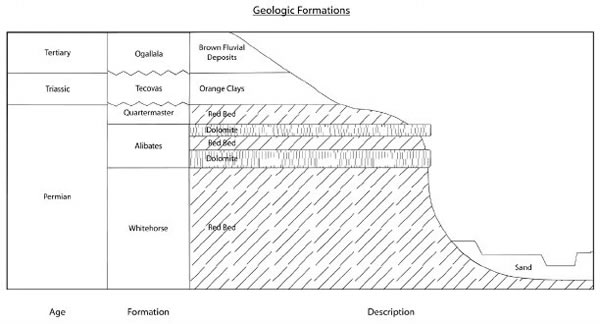Texas
Type |
Symbol |
Year Est. |
|---|---|---|
State Stone |
Petrified Palmwood |
1969 |
State Gem |
Texas Blue Topaz |
1969 |
State Dinosaur |
Paluxysaurus Jonesi |
1997 |
State Precious Metal |
Silver |
2007 |
State Stone: Petrified Palmwood
Petrified wood is not actual wood, however it was wood at one point. Petrified wood is a fossil that formed from pieces of wood that have been mineralized. Mineralization is a process where groundwater moves through the wood and replaces all of the wood molecules with molecules of other substances, most often silica (i.e. quartz). This means that petrified wood actually isn't wood anymore, but a fossil of the former wood.
Related: Arizona State Fossil - Petrified Wood (Araucarioxylon arizonicum); Louisiana State Fossil: Petrified Palmwood; Mississippi State Stone: Petrified Wood; North Dakota State Fossil: Teredo Petrified Wood; Washington State Gem: Petrified Wood
State Gem: Texas Blue Topaz
State Dinosaur: Paluxysaurus Jonesi
State Precious Metal: Silver
References
https://statesymbolsusa.org/states/united-states/texas
Geology of Texas's National Parks
Through Pictures
(at least the one's I have been to)
Alibates Flint Quarries National Monument
San Antonio Missions National Historical Park
National Parks visited but I have no pictures (at this time) to do a geology post
(link directs to NPS site)
Chamizal National Memorial (2004)
Lake Meredith National Recreation Area (2005)
Lyndon B. Johnson National Historical Park (2005)
Alibates Flint Quarries National Monument
Visited in 2005
The Alibates Flint Quarries National Monument is nestled up right next to the Lake Meredith National Recreation Area, so it is an easy two for one National Park stop.
.jpg)
Located in the panhandle section of Texas, this area is known for it's extensive plains and the hard caprock that covers most of the region. The Red Beds of the region were deposited during the Permian Period, approximately 260 million years ago. The rocks deposited in these two parks include sandstones, siltstones, and mudstones, as well as gypsum and dolomite deposits. The red beds are made up of the Whitehorse Sandstone, Cloud Chief Gypsum, and Quartermaster Formation. The red in these red beds are produced by small amounts of iron oxide, AKA rust, mixed into the rock units.

Upper geology layers found at Alibates Flint Quarries. Image courtesy of Quigg et al., 2011.
The red beds, ending with the Whitehorse Sandstone on the top, are all very soft deposits where any significant amount of rain can easily erode away the rocks. However the arid environment of the region helps preserve these softer beds, as well as the harder, more erosion resistant "caprock" that was deposited on top of the red beds.
.jpg)
Over time the sea level slowly rose, eventually inundating this region under a shallow sea. Once the sea transgressed into the region, deposition of the Alibates Dolomite started and was produced from the plant and animal life living in the water (plankton, shelled animals, algae, corals). Dolomite is a variety of limestone where the primary mineral is dolomite (CaMg(CO3)2) instead of calcite (CaCO3). While calcite and dolomite for the most part are nearly indistinguishable to the naked eye, dolomite is generally less dissolvable than calcite, has a slightly higher hardness, and the crystals of dolomite typically have a slight curve to them while calcite surfaces as generally flat. The deposition of the dolomite layer created a "caprock" to the softer red beds below and can be seen in the photo above towards the top of the red slope surface.
.jpg)
The Alibates Dolomite caprock creates flat areas known as mesas (Spanish for table), which are periodically broken up by cracks in the dolomite and stream erosion. Over time some parts of the dolomite had slowly been altered to flint. Flint is a rock where the host mineral, here dolomite, has slowly been replaced molecule by molecule by a microcrystalline quartz known as silica. Flint, chert, and jasper are all microcrystalline quartz rocks that are produced in similar ways. The naming differences are often subjective to the uses for the particular rock where rocks with known archeological significance are called flints, as in this instance.
.jpg)
The source of the silica for the flint is partially a mystery though. There are several hypotheses for where it could have come from. One theory is that an eruption from the Yellowstone supervolcano dropped ash in the area 675,000 years ago. Ash is predominantly silica (quartz) and has been found in several areas of the park in beds up to three feet thick. It is also possible silica was brought in during deposition of the overlying Ogallala Formation which brought in sediment from the Rocky Mountains of Colorado and New Mexico around 10 million years ago. And a third theory is that immediately after the formation of the dolomite, the dolomite was then replaced by the silica nearly instantaneously in a geological sense.
.jpg)
The quality of the flint is heavily dependent on the size of the quartz crystals. While in modern day, large quartz crystals may be more visually appealing, large crystals were considered "garbage" and were thrown away by Indigenous people because it reduced the effectiveness of the flint as a cutting tool. Larger crystals were produced along cracks of the dolomite, similar to a geode, where the space allows the crystal to grow with the groundwater. The finer the quartz crystals, the sharper the edge that was possible in the flint. Flint pits, as is seen here, were dug up to try and harvest the fresh flint that had not been weathered.
References
https://www.nps.gov/alfl/learn/nature/geology.htm
https://geology.com/rocks/flint-chert-jasper/
San Antonio Missions National Historical Park
Visited in 2005
San Antonio Missions is comprised of four missions that stretch out to the south of San Antonio along the San Antonio River. Starting north to south the missions are Mission Concepción, Mission San José, Mission San Juan, and Mission Espada. A fifth mission in the area, Mission San Antonio de Valero, better known as the Alamo is not part of the park but likely has a similar building history.
Mission Concepción
Built in the late 1700's, all of the missions seemed to have been built from the same building stones that were all available within the region. It appears that there were three primary stones chosen in the construction. Near the Mission Concepción is a quarry that was used to obtain the walls for the missions. The stones found here are a calcareous sandy tuffaceous limestone.
Mission Concepción
McDowell, 1997 recounts the historic observations of these building stones from Ferdinand Roemer when he traveled to the San José Mission in 1846. He stated that one of the stones is ...
"... a light, porous, tufaceous limestone or travertine, which is also found in many parts of Germany, ... where it is valued highly as a building material on account of its lightness. This stone formation finds its particular origin in the deposits of springs containing lime. The cupolas and arched ceiling of the churches in the Missions are built of this material."
Mission San José
The carved elements of the building however come from a limestone that is much softer and purer. Romer stated this about that stone:
"The other stone used is a greenish gray limestone, containing clay, which has the peculiar property of being almost soft enough to be cut with a knife when taken from the quarry, but later hardens when exposed to the air. This peculiar mineralogical product is mentioned in several writings as being found in the region of San Antonio. This limestone, whose geological age can be determined by the numerous fossils, - particularly species of the family Exogyra,-enclosed in it, belongs to the Cretaceous formation and is found in several places in the neighborhood of San Antonio."
Mission San José
Based on the inclusion of Exogyra (a Cretaceous age oyster) as well as other factors and fossils within the limestone, it can be assumed that this ornamental limestone was from the Austin Chalk Group, an Upper Cretaceous formation deposited between 89 and 84 million years ago. Formed in the shallow to deep marine deposits along the northern edges of the Gulf of Mexico, the Austin Chalk Group is a series of different formations of which the chalk itself is only part. In the chalk, the majority of the rock is almost solid fossils with Exogyra only being a small percentage. The majority of the fossils are those of coccoliths, which are the microscopic shells of organisms called coccolithophores.
Mission San Juan
The limestone that had been used for the majority of the building's construction was also used as a mortar to cement the building blocks together since when wetted, the limestone dust dried hard as concrete.
Mission San Juan
There is a possibility that other local stones were also used including the local Anacacho Limestone, Pecan Gap Chalk, and Edwards Limestone.
Mission Espada
The final distinct building stone is a red sandstone. Although I can't find a positive identification for the sandstone, the sandstone used in the building is strongly cross bedded and may perhaps be the local Escondido Sandstone or Indio formation.
Mission Espada
Regardless, there is a lot of geology embedded in this park.
References
https://core.ac.uk/download/pdf/76382277.pdf
https://www.nps.gov/parkhistory/online_books/geology/publications/bul/845/sec9.htm
https://www.searchanddiscovery.com/pdfz/documents/2019/51598godet/ndx_godet.pdf.html
https://ngmdb.usgs.gov/mapview/?center=-98.481,29.417&zoom=14


